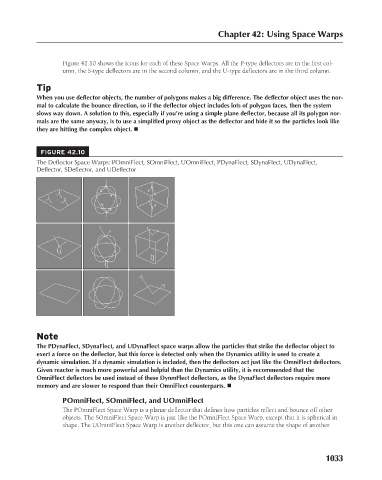Page 1081 - Kitab3DsMax
P. 1081
Figure 42.10 shows the icons for each of these Space Warps. All the P-type deflectors are in the first col-
umn, the S-type deflectors are in the second column, and the U-type deflectors are in the third column.
Tip
When you use deflector objects, the number of polygons makes a big difference. The deflector object uses the nor-
mal to calculate the bounce direction, so if the deflector object includes lots of polygon faces, then the system
slows way down. A solution to this, especially if you’re using a simple plane deflector, because all its polygon nor-
mals are the same anyway, is to use a simplified proxy object as the deflector and hide it so the particles look like
they are hitting the complex object. n Chapter 42: Using Space Warps
FIGURE 42.10
The Deflector Space Warps: POmniFlect, SOmniFlect, UOmniFlect, PDynaFlect, SDynaFlect, UDynaFlect,
Deflector, SDeflector, and UDeflector
Note
The PDynaFlect, SDynaFlect, and UDynaFlect space warps allow the particles that strike the deflector object to
exert a force on the deflector, but this force is detected only when the Dynamics utility is used to create a
dynamic simulation. If a dynamic simulation is included, then the deflectors act just like the OmniFlect deflectors.
Given reactor is much more powerful and helpful than the Dynamics utility, it is recommended that the
OmniFlect deflectors be used instead of these DynmFlect deflectors, as the DynaFlect deflectors require more
memory and are slower to respond than their OmniFlect counterparts. n
POmniFlect, SOmniFlect, and UOmniFlect
The POmniFlect Space Warp is a planar deflector that defines how particles reflect and bounce off other
objects. The SOmniFlect Space Warp is just like the POmniFlect Space Warp, except that it is spherical in
shape. The UOmniFlect Space Warp is another deflector, but this one can assume the shape of another
1033

